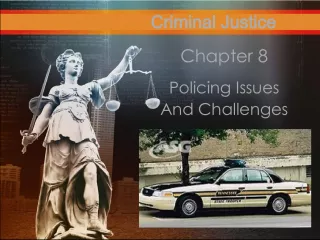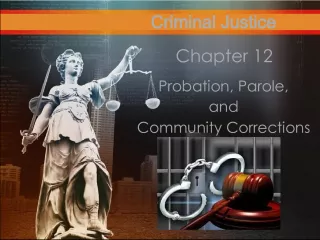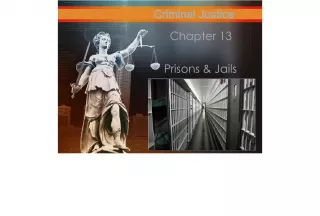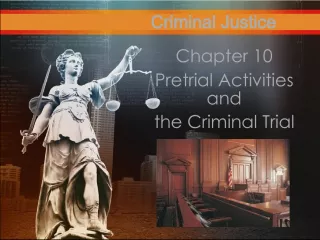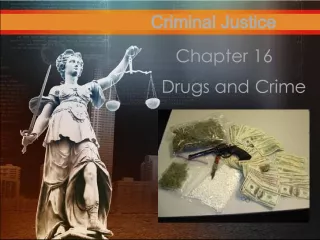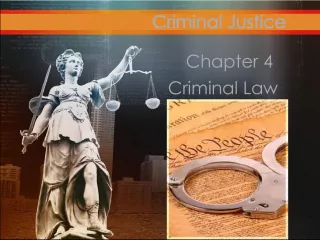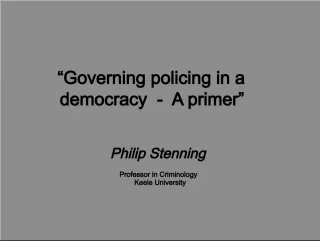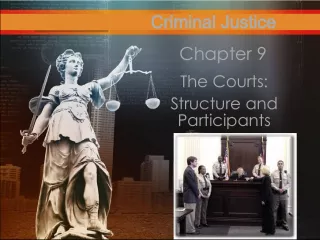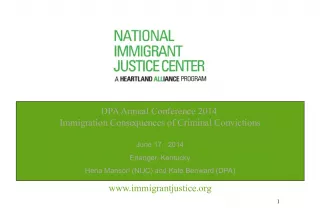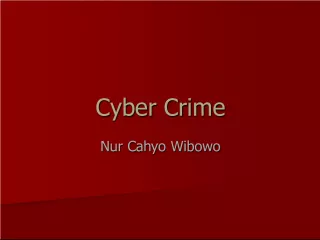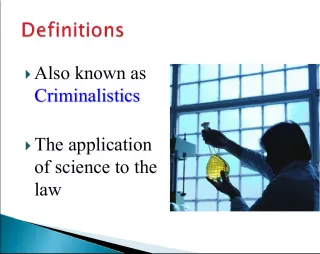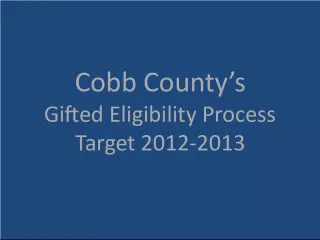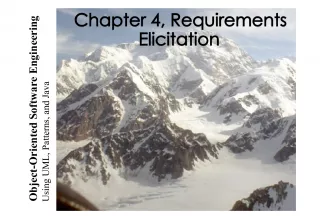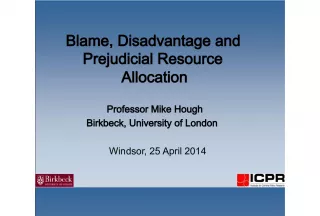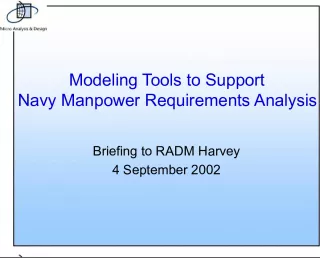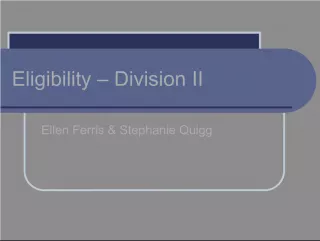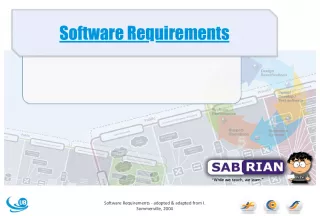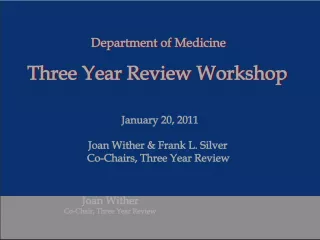Policing and Due Process Requirements in Criminal Justice Today


This chapter focuses on the legal aspects of policing in the criminal justice system, specifically addressing due process requirements relevant to the police. These requirements involve evidence and interrogation, search and seizure
- Uploaded on | 0 Views
-
 dhipurajesh
dhipurajesh
About Policing and Due Process Requirements in Criminal Justice Today
PowerPoint presentation about 'Policing and Due Process Requirements in Criminal Justice Today'. This presentation describes the topic on This chapter focuses on the legal aspects of policing in the criminal justice system, specifically addressing due process requirements relevant to the police. These requirements involve evidence and interrogation, search and seizure. The key topics included in this slideshow are . Download this presentation absolutely free.
Presentation Transcript
Slide1Criminal Justice TodayChapter 7 Policing: Legal Aspects Criminal Justice
Slide2© 2013 by Pearson Higher Education, IncUpper Saddle River, New Jersey 07458 • All Rights Reserved Due Process Requirements Most due process requirements relevant to the police involve: • Evidence and interrogation (search and seizure) • Arrest • Interrogation Fourth Amendment “The right of the people to be secure in their persons, houses, papers, and effects, against unreasonable searches and seizures, shall not be violated, and no Warrants shall issue, but upon probable cause, supported by Oath or affirmation, and particularly describing the place to be searched, and the persons or things to be seized.”
Slide3© 2013 by Pearson Higher Education, IncUpper Saddle River, New Jersey 07458 • All Rights Reserved The Exclusionary Rule Weeks v. U.S. (1914) established the exclusionary rule . • Illegally seized evidence cannot be used in a trial. • Acts as a control over police behavior. • The decision was only binding to federal officers. Fruits of the Poisonous Tree Doctrine Silverthorne Lumber Co. v. U.S. (1920) • Because illegally seized evidence cannot be used in a trial, neither can evidence that derives from an illegal seizure. (photos of evidence illegally seized & then returned)
Slide4© 2013 by Pearson Higher Education, IncUpper Saddle River, New Jersey 07458 • All Rights Reserved Search Incident to Arrest U.S. v. Rabinowitz (1950) • The Fourth Amendment protects against unreasonable searches, but it protects people, not places. • A limited area search following arrest may be acceptable. Chimel v. U.S. (1969) Clarified the scope of a search incident to an arrest. • Officers may search: – The arrested person – The area under the arrested person’s “immediate control” – Officers can search for following reasons: To protect themselves To prevent destruction of evidence To keep defendant from escaping
Slide5© 2013 by Pearson Higher Education, IncUpper Saddle River, New Jersey 07458 • All Rights Reserved Fourth Amendment Protects People Minnesota v. Olson (1990) • Overnight guests residing in the home of another Minnesota v. Carter (1998) • Expectation of privacy (overnight guests expect privacy, plumber/repairmen don’t) Georgia v. Randolph (2006) • One resident consents but the other refuses—police can’t search
Slide6© 2013 by Pearson Higher Education, IncUpper Saddle River, New Jersey 07458 • All Rights Reserved Good Faith Exception to the Exclusionary Rule U.S. v. Leon (1984) • When law enforcement officers have acted in good faith, the evidence they collect is admissible even if later it is found that the warrant they used was invalid. • Good faith can be established if the police reasonably believe they are performing their job in accordance with the law. • Police officers cannot be held responsible for a clerical error. • The exclusionary rule was intended to deter police misconduct, not clerical mistakes made by court employees. • When police mistakes are the result of isolated negligence, the exclusionary rule does not apply Other Exceptions “Inevitable discovery”-tainted evidence can be used if Court feels it would have turned up no matter what “Honest mistakes”- officers searching wrong apartment on the same floor, etc.
Slide7© 2013 by Pearson Higher Education, IncUpper Saddle River, New Jersey 07458 • All Rights Reserved Plain View Doctrine Harris v. U.S. (1968) • Objects falling in “plain view” of an officer, who has the right to be in the position to have the view, are subject to seizure and may be introduced as evidence. Arizona v. Hicks (1987) • Restricted the plain view doctrine – Officers cannot move objects to gain a view of evidence otherwise hidden from view. – Officers cannot move or dislodge objects to create “plain view.” Horton v. California (1990) • The U.S. Supreme Court held that even though inadvertence is a characteristic of most legitimate plain view seizures, it is not a necessary condition. – It is okay to seize evidence found when such evidence is other than that listed in a search warrant.
Slide8© 2013 by Pearson Higher Education, IncUpper Saddle River, New Jersey 07458 • All Rights Reserved Emergency Searches Brigham City v. Stuart (2006) • Police officers “may enter a home without a warrant when they have an objectively reasonable basis for believing than an occupant is seriously injured or imminently threatened with such an injury.” Three threats provide justification for emergency warrantless searches (searching during exigent circumstances). • Clear dangers to life • Clear dangers of escape • Clear dangers of removal or destruction of evidence Warden v. Hayden (1967)- “4th Amendment does not require police to delay in the course of an investigation if to do so would gravely endanger their lives or the lives of others.”
Slide9© 2013 by Pearson Higher Education, IncUpper Saddle River, New Jersey 07458 • All Rights Reserved Emergency Searches Maryland v. Buie (1990) • Police can search locations in a house where a potentially dangerous person could hide while an arrest warrant is being served. – Primarily meant to protect officers from danger. – Can apply when officers lack a warrant, probable cause, or even reasonable suspicion. Hudson v. Michigan (2006) • Evidence was still admitted at trial even though police did not follow knock- and-announce rule • Interests violated by not announcing have nothing to do with the seizure of evidence
Slide10© 2013 by Pearson Higher Education, IncUpper Saddle River, New Jersey 07458 • All Rights Reserved Anticipatory Warrants U.S. v. Grubbs (2006) • The Court upheld the constitutionality of anticipatory warrants —search warrants issued on the basis of probable cause to believe that evidence of a crime, while not currently at the place described, will likely be there when the warrant is executed.
Slide11© 2013 by Pearson Higher Education, IncUpper Saddle River, New Jersey 07458 • All Rights Reserved Felony Arrest Arrest : the act of taking an adult or juvenile into physical custody, by authority of law, for the purpose of charging the person with a criminal offense, delinquent act, or a status offense, terminating with the recording of a specific offense Payton v. New York (1980) • Unless granted consent or an emergency, an arrest warrant is necessary if entering a suspect’s home • Reiterated in Kirk v. Louisiana (2002)
Slide12© 2013 by Pearson Higher Education, IncUpper Saddle River, New Jersey 07458 • All Rights Reserved “Free-to-Leave” Test U.S. v. Mendenhall (1980) • U.S. Supreme Court said: – “A person has been ‘seized’ within the meaning of the Fourth Amendment only if in view of all the circumstances surrounding the incident, a reasonable person would have believed that he was not free to leave.” Yarborough v. Alvarado (2004) • Whether a person is actually free to leave can only be determined by examining the totality of the circumstances surrounding the interrogation (brought to station by police, told that they are under arrest, etc.)
Slide13© 2013 by Pearson Higher Education, IncUpper Saddle River, New Jersey 07458 • All Rights Reserved The “Terry” Stop Terry v. Ohio (1968)- two men casing a store were stopped & frisked by officer Reasonable suspicion- ( level of suspicion that would justify an officer in making further investigation) is needed to “stop and frisk.” The facts must lead officers to suspect that crimes may be occurring, and that suspects may be armed. • Reasonable suspicion is a general and reasonable belief that a crime is in progress or has occurred whereas probable cause is a reasonable belief that a particular person has committed a specific crime. Justification: • “We cannot blind ourselves to the need for law enforcement officers to protect themselves and other prospective victims of violence in situations where they may lack probable cause for an arrest.”
Slide14© 2013 by Pearson Higher Education, IncUpper Saddle River, New Jersey 07458 • All Rights Reserved Reasonable Suspicion Stops U.S. v. Sokolow (1989) • Stops must be evaluated based on a “totality of circumstances” (all aspects of a suspect’s behavior taken in concert) U.S. v. Arvizu (2002) • “Officers are allowed to draw on their own experiences and specialized training”
Slide15© 2013 by Pearson Higher Education, IncUpper Saddle River, New Jersey 07458 • All Rights Reserved Reasonable Suspicion Searches Hiibel v. Sixth Judicial District Court of Nevada (2004) • The court upheld Nevada’s “stop and identify” law that requires a person to identify himself to police if they encounter him under circumstances that reasonably indicated that he “has committed, is committing, or is about to commit a crime.” Smith v. Ohio (1990) • An individual has the right to protect his belongings from unwarranted police inspection.
Slide16© 2013 by Pearson Higher Education, IncUpper Saddle River, New Jersey 07458 • All Rights Reserved Vehicle Searches *Vehicles are “movable crime scenes.” Carroll v. U. S. (1925) • Warrantless search is valid if based on reasonable belief that contraband is present Preston v. U. S. (1964) • Defined the limitations of warrantless vehicle searches • Police must get warrant if time & circumstances permit Ex. Vehicle has been towed & is in custody Arizona v. Gant (2009) • Vehicle searches “incident to a recent occupant’s arrest” cannot be authorized without a warrant if there is “no possibility the arrestee could gain access to the vehicle at the time of the search”
Slide17© 2013 by Pearson Higher Education, IncUpper Saddle River, New Jersey 07458 • All Rights Reserved Vehicle Searches Maryland v. Wilson (1997) • Passengers ordered out of vehicle for officer safety and are subject to police control People v. Brendlin (2007) • Officers will exercise “unquestioned police command” over passengers for the duration of the stop Illinois v. Caballes (2005) • The use of a drug-sniffing dog may not even be classified as a “search”
Slide18© 2013 by Pearson Higher Education, IncUpper Saddle River, New Jersey 07458 • All Rights Reserved Roadblocks and Checkpoints Indianapolis v. Edmond (2000) • The Fourth Amendment prohibits even a brief seizure of a motorist under a program whose primary purpose is ultimately indistinguishable from the general interests in crime control. • Checks for drivers’ licenses and registrations are okay because they do not intend to “detect evidence of ordinary criminal wrongdoing”. Illinois v. Lidster (2004) • Information-seeking highway roadblocks are permissible. • “The law ordinarily permits police to seek the public’s voluntary cooperation in a criminal Investigation.”
Slide19© 2013 by Pearson Higher Education, IncUpper Saddle River, New Jersey 07458 • All Rights Reserved Watercraft and Motor Homes U. S. v. Villamonte-Marquez (1983) • Permitted warrantless searches of watercraft California v. Carney (1985) • Permitted warrantless searches of motor homes U. S. v. Hill (1988) • Extended warrantless searches to include houseboats
Slide20© 2013 by Pearson Higher Education, IncUpper Saddle River, New Jersey 07458 • All Rights Reserved Suspicionless Searches Suspicionless searches may be necessary in order to ensure public safety. Such searches must be based on compelling interests. Ex. Mandatory drug testing for workers Suspicionless searches of vehicles at our nation’s borders are permitted, even when searches are extensive. U.S. v. Flores-Montano (2004) • “The Government’s authority to conduct suspicionless inspections at the border includes the authority to remove, disassemble, and reassemble a vehicle’s fuel tank.”
Slide21© 2013 by Pearson Higher Education, IncUpper Saddle River, New Jersey 07458 • All Rights Reserved High-Technology Searches • Investigating crime is making greater use of high-technology devises and practices, such as thermal imaging devises. • If the government searches a home using a device that is not something used by the general public, and that shows something that wouldn’t be learned without entering the house, then a warrant is required.
Slide22© 2013 by Pearson Higher Education, IncUpper Saddle River, New Jersey 07458 • All Rights Reserved Intelligence Function Police gather information through many sources, including: • Informants • Interrogation
Slide23© 2013 by Pearson Higher Education, IncUpper Saddle River, New Jersey 07458 • All Rights Reserved Two-Pronged Test for the Use of Informants In the case of informants, a two-pronged test usually satisfies the probable cause requirement per Aguilar v. Texas (1964). #1: The source of the informant’s information is made clear. # 2: The police officer has a reasonable belief that the informant is reliable. Alabama v. White (1990) • Without other information, anonymous tips may be used if they accurately predict future behavior
Slide24© 2013 by Pearson Higher Education, IncUpper Saddle River, New Jersey 07458 • All Rights Reserved Police Interrogation An interrogation refers to the information-gathering activity of police officers that involves the direct questioning of suspects. During an interrogation, there must be no: • Physical abuse • Inherent coercion (tactics just shy of physical abuse) • Psychological manipulation (by professionals) • Suspects have a right to legal counsel during interrogation (Miranda) • A waiver of Miranda rights can be done if such a waiver is voluntary, knowing, and intelligent. • Silence is not a waiver. Inevitable Discovery Exception to Miranda Nix v. Williams (1984) • Evidence, even if it was otherwise gathered inappropriately, can be used in a court of law if it would have invariably turned up in the normal course of events.
Slide25© 2013 by Pearson Higher Education, IncUpper Saddle River, New Jersey 07458 • All Rights Reserved Nontestimonial Evidence Nontestimonial evidence generally refers to physical evidence, including very personal items that may be within or part of a person’s body, such as: • Ingested drugs • DNA • Foreign objects • Blood • Medical implants Concerns over non-testimonial evidence involve: • Right to privacy issues • Body cavity searches • Electronic eavesdropping • Electronic evidence
Slide26© 2013 by Pearson Higher Education, IncUpper Saddle River, New Jersey 07458 • All Rights Reserved Body-Cavity Searches • Strip searches of convicts in prison, including the search of body cavities, have generally been held to be permissible. U.S. v. Montoya de Hernandez (1985) • The Court upheld a four-day customs detention of a body packer (until nature took its course and evidence was passed from her body). Schmerber v. California (1966) • Warrants must be obtained for bodily intrusions unless fast action is necessary to prevent the destruction of evidence by natural physiological processes.
Slide27© 2013 by Pearson Higher Education, IncUpper Saddle River, New Jersey 07458 • All Rights Reserved Electronic Eavesdropping Katz v. U.S. (1967) • A warrant is required to unveil what a person makes an effort to keep private, even in a public place. • Title III of the Omnibus Crime Control and Safe Streets Act of 1968 permits officers to listen to electronic communications when certain conditions are met Minimization Requirement U.S. v. Scott (1978) • Officers must make every reasonable effort to monitor only those conversations that are specifically related to the criminal activity under investigation.
Slide28© 2013 by Pearson Higher Education, IncUpper Saddle River, New Jersey 07458 • All Rights Reserved The USA PATRIOT Act of 2001 The USA PATRIOT Act of 2001 made it easier for police investigators to intercept many forms of electronic communication. The Act: • allows for roving, multi-point wiretaps • broadened “sneak and peek” searches • updated and expanded the types of records that law enforcement can obtain with a subpoena Uniting and Strengthening America by Providing Appropriate Tools Required to Intercept and Obstruct Terrorism Act or USA PATRIOT Act
Slide29© 2013 by Pearson Higher Education, IncUpper Saddle River, New Jersey 07458 • All Rights Reserved Gathereing Electronic Evidence Electronic evidence is of special concern because it: • is latent (not readily seen by the unaided eye) • can transcend national and state borders quickly and easily • is fragile and can easily be altered, damaged, compromised, or destroyed by improper handling or improper examination • may be time sensitive Warrantless Searches of Electronic Evidence U.S. v. Carey (1999)—A federal appellate court held that the consent a defendant had given to police for his apartment to be searched did not extend to the search of his computer once it was taken to police station. U.S. v. Turner held that the warrantless search of a personal computer while in the defendant’s apartment exceeded the scope of his consent.
